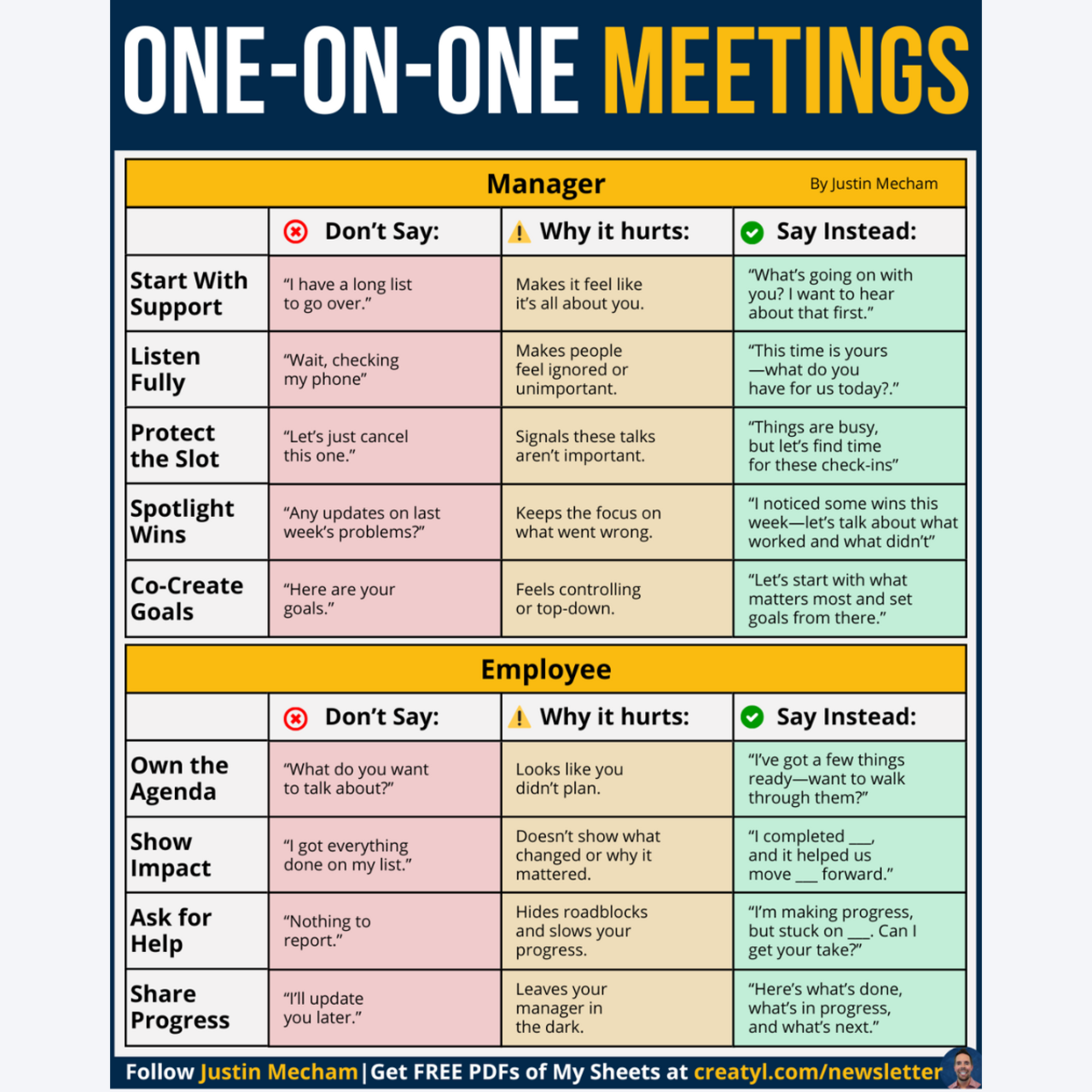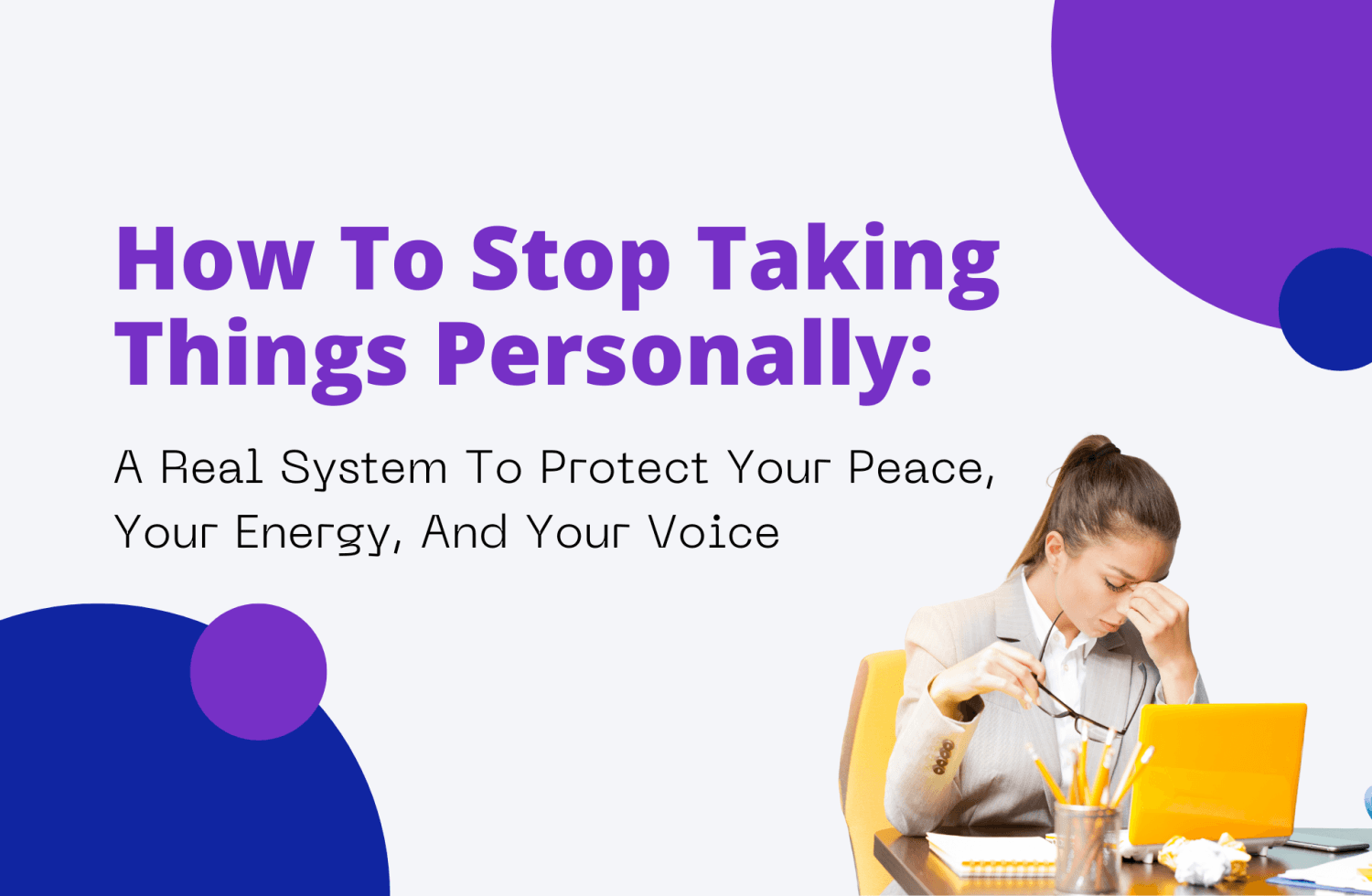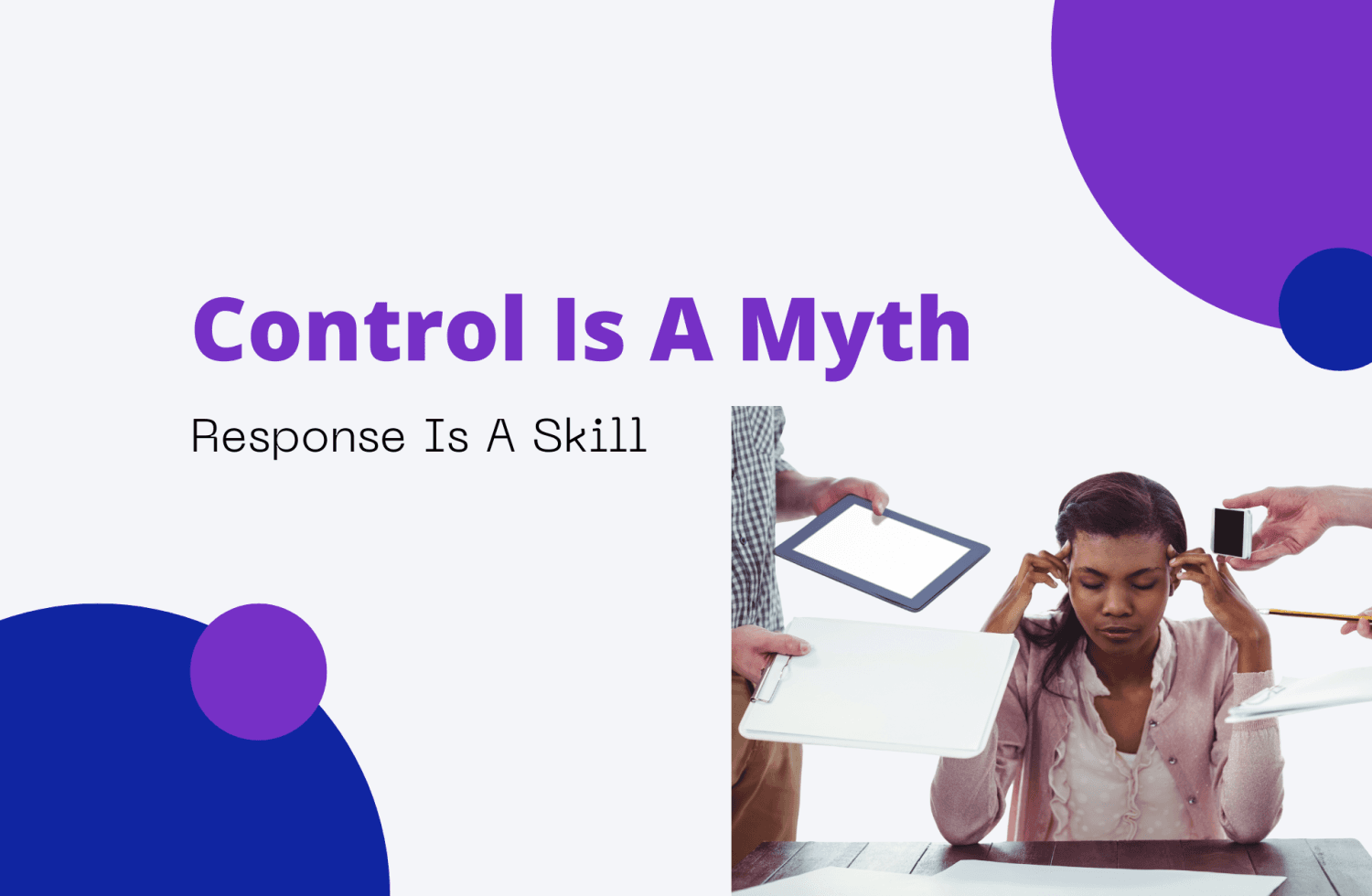Click Here to Download Today's Infographic.
Let’s be honest.
Most one-on-one meetings feel more like rushed status updates than real conversations.
You skim your notes, check your calendar, and dive straight into the to-do list.
Maybe you get through everything. Maybe you don’t.
But either way, it feels like something got left on the table—something that could’ve actually made a difference.
That’s the trap: we start treating one-on-ones like another box to check, not the one space where real connection, support, and progress can actually happen.
But here’s the thing: when done right, these 30 minutes can become the most valuable time in your entire week—for both people in the room.
It’s where small things get noticed before they become big problems.
Where blockers get named early. Where ideas get shared before they’re polished.
And maybe most importantly—it’s where trust gets built, one quiet, thoughtful moment at a time.
Most of us aren’t lacking meetings. We’re lacking meetings that matter.
And that starts with rethinking how we show up in our one-on-ones.
What’s Actually Broken in Most One-on-Ones
Let’s get clear: one-on-ones aren’t status reports.
They aren’t performance reviews. And they definitely aren’t something you should be winging five minutes before the Zoom call.
Yet that’s how a lot of them go.
Most one-on-ones fall into one of two traps:
- The tactical trap: where the conversation becomes a run-through of project updates, deadlines, and tasks.
- The vague trap: where the meeting lacks structure and purpose, and becomes a disjointed check-in with no direction.
Here’s why both are a problem:
When it’s all tactics, people aren’t being seen—they’re being audited.
You might get a sense of progress, but you’re missing the bigger picture: how they’re really doing, what’s getting in their way, and what they’re not saying out loud.
When it’s all vague, you might get lucky and land on a meaningful topic—but more often, you get 30 minutes of wandering conversation that doesn’t lead to clarity, alignment, or action.
In both cases, the meeting ends up feeling like time spent, not time invested.
And if your team is walking out of one-on-ones feeling confused, checked out, or worse—like nothing changed—then something’s off.
One-on-ones aren’t supposed to drain people. They’re supposed to anchor them.
What a Great One-on-One Actually Looks Like
So what does a one-on-one look like when it’s actually working?
It’s not about perfection. It’s not about the perfect script or the right agenda template.
It’s about what happens when the conversation gets real.
Here’s what that shift looks like:
- Managers stop talking at people and start listening to them.
- Employees stop reporting up and start showing up.
- Managers move from reaction to reflection. From putting out fires to coaching people through them.
- Employees stop hiding what’s hard and start sharing what’s true—before it spirals into something bigger.
This doesn’t mean scrapping structure.
It means using structure to create space—for honesty, for insight, for direction.
And it means rethinking the metrics you’re tracking:
- Clarity over results: Because you can’t fix what you don’t understand.
- Support over checklists: Because progress comes faster when people feel backed.
- Co-creation over control: Because the best goals are the ones built together.
- Progress over perfection: Because waiting for things to be polished is how momentum dies.
One-on-ones don’t need to be long to be meaningful. But they do need to be real.
And that starts with both people in the room choosing to show up differently.
Real Stories That Show the Shift (PAS Framework)
Here are three real-life, workplace examples that show what this shift looks like in action.
These are longer, fuller moments—because real conversations rarely happen in bullet points.
The Update That Wasn’t Working
A product designer was falling behind. Deadlines kept getting missed, but during one-on-ones, everything sounded fine.
The designer ran through a list of tasks and said things like, “Almost done” and “It’s in progress.”
The manager assumed things were just taking longer than expected.
But the reality was very different.
The designer was stuck on a technical piece of the project and didn’t want to admit they didn’t understand part of the handoff.
They were trying to learn it on their own after hours—exhausting themselves and still falling short.
Meanwhile, the manager started growing quietly frustrated. The relationship began to fray.
One week, the manager shifted the tone.
They opened the meeting with: “What’s something that’s felt harder than it should lately?”
The designer paused. Then admitted they didn’t know how to use a core design system component.
Instead of reacting, the manager asked, “Who on the team could walk you through it?”
A teammate offered help. The work unblocked. The tension eased.
And the one-on-one became a space where honesty could exist without fear.
Checklists Don’t Build Trust—Stories Do
A customer success lead was doing solid work—but it wasn’t getting noticed.
In every one-on-one, they walked through a list: “I followed up with three clients. I created a report.
I logged feedback.” It all sounded fine, but nothing ever stuck.
The manager felt like the meetings were repetitive.
The employee started to wonder if their work even mattered. Neither felt energized after those check-ins.
It became something to get through, not something to look forward to.
The employee decided to shift the frame.
Instead of listing tasks, they shared context:
“I followed up with a frustrated client last week. They were ready to churn. I stayed on the call 20 minutes longer than expected—and they renewed for another quarter. Here’s what I learned from that.”
Suddenly, the manager leaned in.
That insight became part of a new retention playbook.
The employee didn’t just report what they did. They showed why it mattered.
That changed everything.
Cancelling One-on-Ones Always Comes With a Cost
A startup founder, juggling back-to-back investor calls, started canceling one-on-ones with their team.
“You’re good, right?” turned into a habit. Some weeks, no one had a one-on-one at all.
Team morale quietly dropped.
One engineer started submitting fewer ideas.
Another team member confided in a peer, “I don’t think leadership cares about our input anymore.”
One person quit. The founder didn’t see it coming. But the silence had been growing for weeks.
The founder decided to restart one-on-ones—but not with the old format.
They created a new agenda: one personal check-in, one work highlight, one question they’d never asked before.
And they committed to never canceling unless it was a true emergency.
The conversations got deeper. The team started speaking up again.
And the founder saw something they hadn’t in months: renewed trust.
The Best Tools and Resources Worth Your Time
There’s a lot of noise out there. But these are the tools and resources people actually use to make their one-on-ones more meaningful:
Book: Glad We Met by Dr. Steven Rogelberg
Based on decades of organizational psychology research, this book offers the clearest, smartest take on why most one-on-ones don’t work—and how to fix them. It’s full of actual structure, conversation starters, and studies that show what helps people open up.
TED Talk: The Power of You to Truly Make Meetings Work by Steven Rogelberg
This short talk reframes how we think about meetings entirely. It’s not about having fewer meetings—it’s about making each one worth it. Especially useful if you’re trying to shift how your company approaches time together.
Also Worth It: Radical Candor by Kim Scott
A must-read for anyone managing humans. It breaks down how to give feedback that’s honest and kind, and why most teams fall apart when they avoid the hard conversations. Perfect complement to your one-on-one toolkit.
Make This the Most Human Time of the Week
The best one-on-ones don’t happen when we say more.
They happen when we say the things that matter.
These 30 minutes aren’t for status reports.
They’re for stories. For struggles. For the questions that don’t fit in Slack messages or stand-ups.
It’s the one moment in a busy week where someone might feel safe enough to say: “I don’t know how to do this.” “I’m stuck but didn’t want to bother anyone.” “I have an idea, but I’m not sure if it’s good.”
Those are the sentences that build trust.
They don’t happen by accident.
They happen because one person created the space—and the other decided to step into it.
When we treat one-on-ones like throwaways, we throw away the things that matter most.
But when we protect them, prepare for them, and show up with presence? They become more than meetings.
They become moments that move people forward.
Want the Visual Version?
You can download the full infographic featured in this article as a clean, printable PDF.
Use it as a guide in your next one-on-one, pin it near your desk, or share it with your team.




